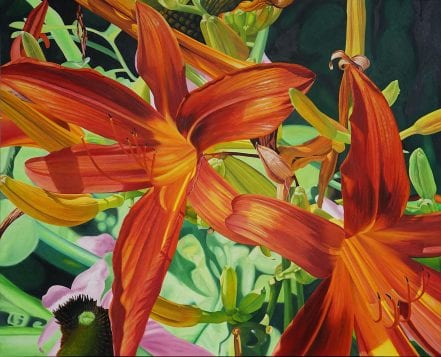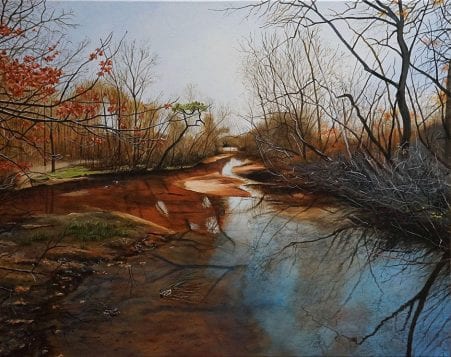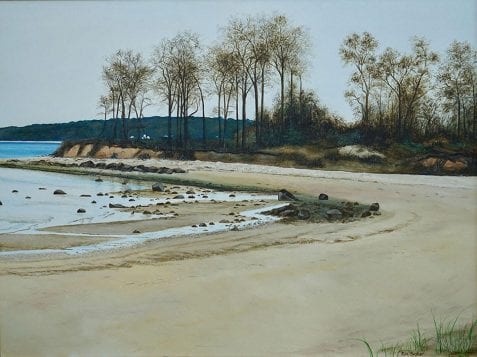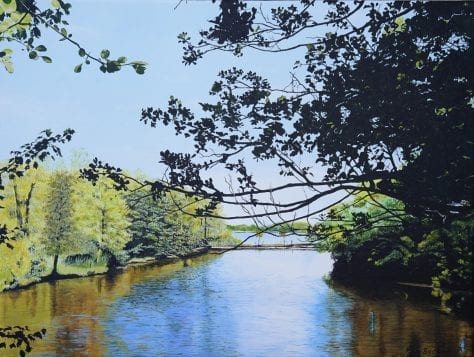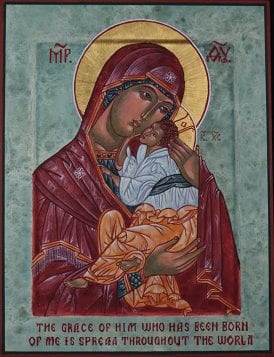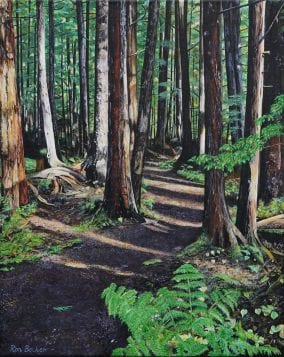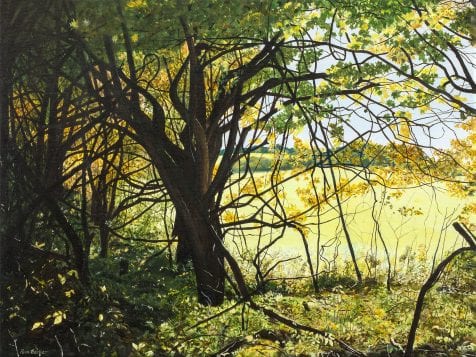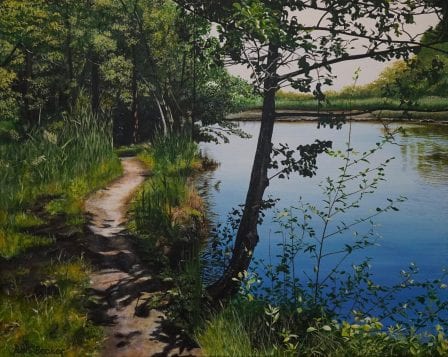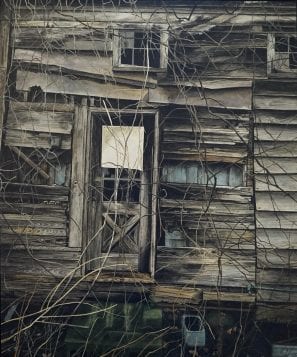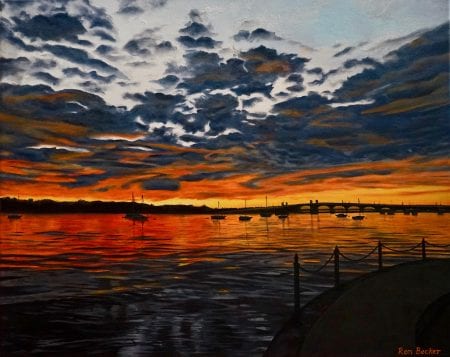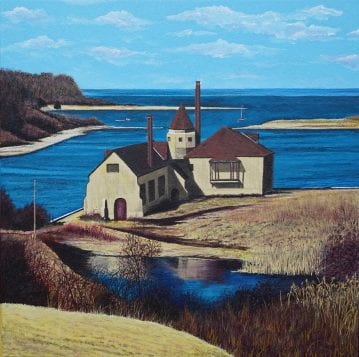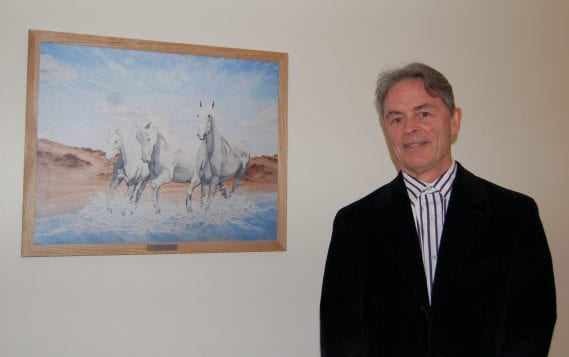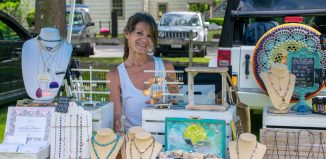Artist of the Month: Ron Becker
By Irene Ruddock
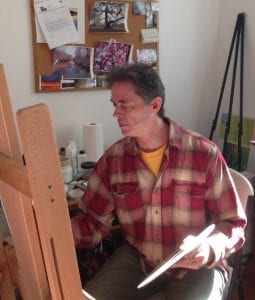
Ron Becker’s talent as a muralist was expressed at any early age where he designed and painted murals at his elementary, junior, and high school. Later, after he received a degree in art from Niagara County Community College (NCCC), he went on to be an art display director. His life took a dramatic turn when he successfully pursued a professional career in entertainment: modeling, acting, singing and dancing in summer stock, television and nightclubs.
Ron eventually began a 27-year career as Director of Therapeutic Recreation in hospitals and nursing homes, where he combined all of his skills in the arts. Today, he is immersed in the fine art world exhibiting leadership skills that have led him to become a former president of the Deer Park Arts Council, while currently serving on the Community Advisory Board of Suffolk County for the Arts, as well as board member on the Babylon Citizens Council of the Arts. Being a lover of the outdoors all his life, he started painting landscapes and nature scenes in oil and acrylic and, today, devotes much of his time to exhibiting in art shows and galleries on Long Island.
How did your art career evolve when you were young?
Raised in western New York, my talent was supported and nurtured by my parents and teachers. I was asked by my fourth and eighth grade teachers to make murals using pastels, and stayed after school to work on them. I attended a summer art camp in Niagara Falls in ninth grade and as a senior in high school I attended a summer camp for artists near Watertown, New York. These opportunities helped expand my confidence and artistic talent. Finally, I attended NCCC and received my Associate’s degree with a major in art, helping to solidify techniques in drawing and painting.
Your career as a muralist has spanned your entire life. What project was most rewarding?
Overseeing murals in Deer Park allowed me to work with the Long Island Railroad, Deer Park Community Association and eight other artists, to complete twelve large mural boards under the Long Island Railroad train trestle. It was very rewarding to help give artists a voice and give something lasting to the community. Painting murals in primary and elementary schools through the Eastern BOCES services gave me the opportunity to work with young artists and show them how a mural is done, start to finish. Their joy and ongoing interest was infectious. Painting murals in hospitals was a gift as well, seeing the therapeutic outcomes for the patients.
Are you working on anything right now?
I was recently involved with Splashes of Hope, an organization dedicated to creating art to transform spaces by painting murals in health care facilities, comforting patients during their healing process. I was asked to paint a ceiling tile of the Coindre Hall Boathouse, next to the home and art studio for Splashes of Hope, located on the grounds of West Neck Farm in Huntington. The finished tile will be installed in the ceiling above a bed on one of the units in Huntington Hospital. I encourage artists who want to paint, with a humanitarian purpose, to contact Splashes of Hope at www.splashesofhope.org.
I have learned that you work extensively for charities that supports the arts. Can you tell me about that?
I became president of the Deer Park Arts Council, a non-profit charity that advocates for and supports the visual and performing arts in the Deer Park School District. I worked with the board to spearhead a variety of fundraising events to offer summer workshops and programs for students to expand their training in the arts, as well as offering financial scholarships to outgoing seniors.
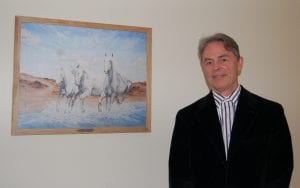
What is your most recent charitable contribution?
Since I spent twenty-seven years as Director of Therapeutic Recreation at nursing homes and hospital, I fully understand the therapeutic value art has for the disabled or sick. Therefore, when I was asked to donate a painting for Mather Hospital’s newly renovated oncology wing, I chose a painting of wild horses galloping on the shore titled Joyous Abandon.
Tell me about your years as Director of Therapeutic Recreation at nursing homes and hospitals.
While Director of Recreation at two city hospitals, outside of my managerial duties, I taught the residents drawing and painting. I was amazed at their progress, joy, and commitment, which inspired me to curate exhibits and work with galleries to exhibit the resident’s work. The facilities also had auditoriums with stages, so I would create backdrops and environments for concerts and special events.
How did you become interested in the impact of art as a tool of social change?
While on a retreat at Chapel House, I got a vision of doing an exhibit on social justice issues after listening to the song “God Weeps.” The first topic I selected was unjust incarceration. After completing my first three pieces, I was introduced to Bartholomew Crawford, a writer who is presently incarcerated at Sing Sing Correctional Facility, and reached out to collaborate.
How did the two of you proceed?
After sharing the exhibit’s intent, Mr. Crawford agreed to send me four written pieces about his prison experience. I integrated them into a collection of visual and narrative pieces to help tell the experience of life behind bars. Four years of working on this has resulted in an exhibit entitled “My Block.” The exhibition will be housed in the jail of Babylon Old Town Hall, which was in service from 1918 to 1958, and is on the National Historical Register. The show will be rescheduled later this year when guidelines are relaxed and allow for public exhibits.
Can you explain what iconography is and what drew you to work in this genre?
Iconography is the practice of creating icons in the ancient method used by monks centuries ago. Its main mediums are egg tempera and gold leaf on a board covered with linen and a plaster/gesso mix. I wanted to integrate my faith and spirituality into my art on some level and met Janine Manheim, an iconographer, at a local art gallery. She had an icon on display that intrigued me, so since that initial meeting, I have been attending her classes.
Could you explain a bit more about the process of egg tempera as a painting medium?
Egg tempera is a recipe of egg yolk and water mixed with mineral pigment color. It creates a translucent look that I strive to create as shown in my icon, Mother of Tenderness.
Why did you decide to devote your time to fine art creating landscapes in oil and acrylic?
I love to interpret the beauty all around us, hoping to motivate others to slow down and see and feel what I experience in nature. Painting is relaxing and allows me to express my inner self, visually. A year before retiring, I turned half my garage into a studio, experimenting with different techniques in both oil and acrylic to help find my voice. Taking photographs while on trips or here on Long Island, I began to interpret what visually excited me. Once I felt confident in sharing some of my work with the public, I began to show my work in outdoor art fairs and in member shows on Long Island.
What has been your best experience so far?
I had a one- man show, “An Artist’s Nature,” at the Bayard Cutting Arboretum in 2019, allowing me to exhibit 43 pieces I had created over the last several years. It was an amazing experience to see all of my work in one space, that could really present my artistic style. I also exhibited at the Roosevelt Island Visual Arts Association, an ethnically diverse group of artists dedicated to enhancing cultural developments through the arts. Due to the success of these shows, I have ventured into exhibiting at several galleries on the Island. I now sell my work through my website www.rbeckerart.com.

